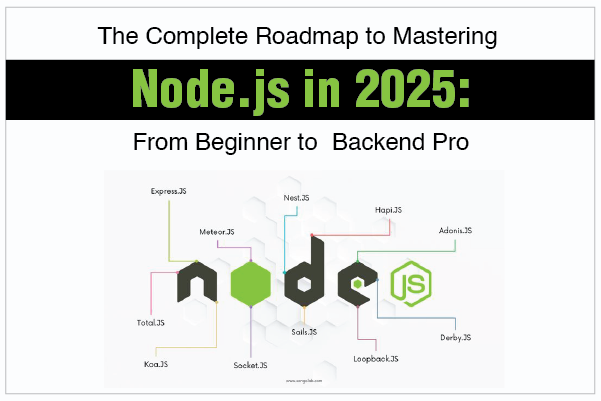The Complete Roadmap to Mastering Node.js in 2025: From Beginner to Backend Pro
Admin
|
May 23, 2025

Unlock your backend development potential with the ultimate 2025 Node.js roadmap. From mastering JavaScript and Node.js core modules to building real-time apps, REST/GraphQL APIs, and deploying with Docker — this guide by Gradient Infotech is your step-by-step path to becoming a backend pro.
Introduction
Byenabling developers to create scalable, high-performance, JavaScript on theserver side, Node.js will continue to rule the scene of backend development in2025. From basic ideas to actual backend project deployment, this Node.jsroadmap will walk you through every necessary step regardless of your level ofexperience: front-end developer switching to full-stack developer.
In thiscomprehensive guide brought to you by Gradient Infotech, we'll break down theessential tools, technologies, and frameworks every Node.js developer mustmaster to stay ahead in today’s competitive job market.
WhyLearn Node.js in 2025?
Node.js stays a topbackend runtime tool because of:
- Blazing-fast performance powered by the V8 JavaScript engine
- Non-blocking, asynchronous I/O model for scalable systems
- Massive ecosystem via npm (Node Package Manager)
- Universal language — JavaScript for both frontend and backend
- Ideal for real-time applications like chat apps, streaming services and collaborative tools
Companieslike Netflix, Uber, PayPal, and LinkedIn rely on Node.js for backendscalability — and the demand for skilled Node.js developers is skyrocketing in2025.
Step-by-StepNode.js Roadmap for 2025
Here’syour full-stack backend roadmap with Node.js — incorporating the most searchedkeywords and modern development stacks.
Step1: Master JavaScript (ES6+)
Beforejumping into Node.js, solidify your JavaScript fundamentals:
- Variables, functions and objects
- Promises and async/await
- Array methods (map, filter, reduce)
- Destructuring, spread/rest operators
- Classes, modules and error correction
Tip:Learn modern JavaScript from online platforms or workshops at GradientInfotech.
Step2: Understand Node.js Core Modules
Onceyour JS basics are strong, start with Node.js core concepts:
- Node.js architecture & event loop
- File system (fs), path, and os modules
- HTTP module for creating servers
- Streams and buffers
- Environment variables & process module
Step3: Learn Express.js — The Most Popular Node.js Framework
Expressis a lightweight and fast framework used in over 80% of Node.js projects.
Focuson:
- Creating RESTful APIs with Express
- Routing, middleware, and controllers
- Request/response handling
- Error handling in Express
- Securing APIs with Helmet and CORS
Step4: Connect to Databases (MongoDB + Mongoose)
Modernbackend applications are data-driven. Learn how to integrate NoSQL databases:
- MongoDB for flexible, JSON-based storage
- Mongoose for data modeling and validation
- CRUD operations with MongoDB
- Aggregation framework for analytics
Step5: Build Real-Time Applications with Socket.io
Real-timeweb applications are in high demand. With Socket.io and Node.js, you can build:
- Chat applications
- Live notifications
- Online gaming platforms
- Collaborative tools (e.g., Google Docs clone)
Step6: Authentication and Authorization
Secureyour applications using modern techniques:
- JSON Web Tokens (JWT)
- OAuth 2.0 integration
- Session-based authentication
- Role-based access control
Step7: Build REST & GraphQL APIs
WhileREST APIs are standard, GraphQL is gaining traction for flexibility in modernapps.
- RESTful API design principles
- CRUD with REST
- Building GraphQL APIs with Apollo Server
- Query, Mutation, Schema design
Step8: Testing and Debugging Node.js Applications
Noprofessional backend developer skips testing:
- Unit testing with Jest or Mocha
- API testing with Postman or Supertest
- Debugging with Node.js inspector or VSCode
Step9: Deployment and Hosting
Makeyour application live using:
- Node.js deployment on platforms like Heroku, Vercel, or DigitalOcean
- Using PM2 for process management
- Dockerize your Node.js apps
- CI/CD pipelines with GitHub Actions
To stand out as a full-stack Node.js developer, learn:
- Docker & Kubernetes basics
- Nginx as a reverse proxy
- Load balancing, monitoring, and logging
- Performance optimization (clustering, caching)
Conclusion
Node.jsis more than just a runtime — it’s an ecosystem that empowers JavaScriptdevelopers to build robust backend systems, APIs and real-time applications. Whether you’replanning to become a full-stack web developer or a backend specialist,following this roadmap will help you navigate the current tech landscape withconfidence.
Ready toLearn Node.js Hands-On?
JoinGradient Infotech’s expert-led Node.js courses and accelerate your backenddevelopment career. Visit https://gradientinfotech.com/ to explore our Node.jsworkshops, hands-on bootcamps, and job-ready certification programs.
Startyour Node.js journey with Gradient Infotech — where backend innovation meetsfuture-ready learning.